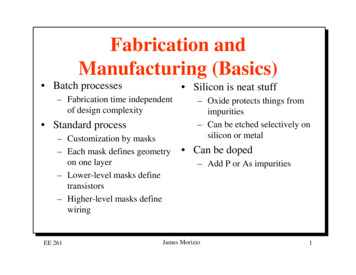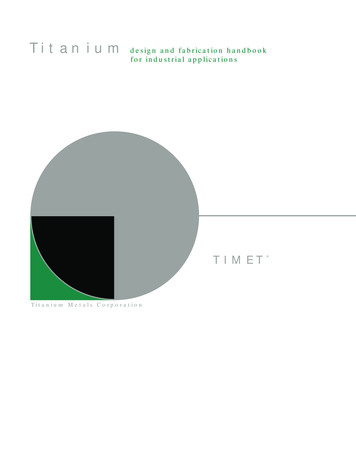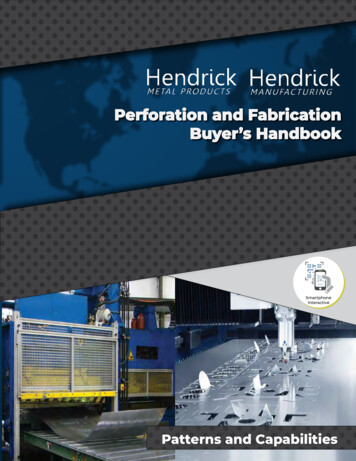
Transcription
Fabrication andManufacturing (Basics) Batch processes Silicon is neat stuff– Fabrication time independentof design complexity Standard process– Customization by masks– Each mask defines geometryon one layer– Lower-level masks definetransistors– Higher-level masks definewiringEE 261– Oxide protects things fromimpurities– Can be etched selectively onsilicon or metal Can be doped– Add P or As impuritiesJames Morizio1
CMOS Fabrication CMOS transistors are fabricated on silicon wafer Lithography process similar to printing press On each step, different materials are deposited oretched Easiest to understand by viewing both top andcross-section of wafer in a simplifiedmanufacturing processEE 261James Morizio2
Making fersEE 261James Morizio3
Inverter Cross-section Typically use p-type substrate for nMOStransistors Requires n-well for body of pMOS transistorsAGNDVDDYSiO2n diffusionn n p substratenMOS transistorEE 261p p n wellp diffusionpolysiliconmetal1pMOS transistorJames Morizio4
Well and Substrate Taps Substrate must be tied to GND and n-well to VDD Metal to lightly-doped semiconductor forms poorconnection called Shottky Diode Use heavily doped well and substrate contacts /tapsAGNDp n n p p n n wellp substratesubstrate tapEE 261VDDYwell tapJames Morizio5
Inverter Mask Set Transistors and wires are defined by masks Cross-section taken along dashed lineAYGNDVDDnMOS transistorpMOS transistorsubstrate tapEE 261James Moriziowell tap6
Detailed Mask Viewsn well Six masks––––––n-wellPolysiliconn diffusionp diffusionContactMetalPolysiliconn Diffusionp DiffusionContactMetalEE 261James Morizio7
Basic Processing Steps N-diffusion created by doping regions of thesubstrate Poly and metal are laid over the substrate, withoxide to insulate them from substrate and eachother Wires are added in layers, alternating with oxide Vias are cut in the oxideEE 261James Morizio8
Fabrication Steps Features are patterned on a wafer by aphotolithographic process– Photo-light lithography, n. process of printing from a plane surfaceon which image to be printed is ink-receptive and the blank area isink-repellant Cover the wafer with a light-sensitive, organic materialcalled photoresist Expose to light with the proper pattern (mask) Patterns left by photoresist can be used to control whereoxide is grown or materials are placed on surface of waferEE 261James Morizio9
Fabrication Steps Layout contains information on what patterns haveto made on the wafer Masks are created using the layout informationprovided by the designer Procedure involves selective removal of the oxide– Coat the oxide with photoresist, polymerized by UVlight (applied through mask)– Polymerized photoresist dissolves in acid– Photoresist itself is acid-resistantEE 261James Morizio10
Fabrication Steps Start with blank wafer Build inverter from the bottom up First step will be to form the n-well––––Cover wafer with protective layer of SiO2 (oxide)Remove layer where n-well should be builtImplant or diffuse n dopants into exposed waferStrip off SiO2p substrateEE 261James Morizio11
Oxidation Grow SiO2 on top of Si wafer– 900 – 1200 C with H2O or O2 in oxidation furnaceSiO2p substrateEE 261James Morizio12
Photoresist Spin on photoresist– Photoresist is a light-sensitive organic polymer– Softens where exposed to lightPhotoresistSiO2p substrateEE 261James Morizio13
Lithography Expose photoresist through n-well mask Strip off exposed photoresistPhotoresistSiO2p substrateEE 261James Morizio14
Etch Etch oxide with hydrofluoric acid (HF)– Seeps through skin and eats bone; nasty stuff!!! Only attacks oxide where resist has been exposedPhotoresistSiO2p substrateEE 261James Morizio15
Strip Photoresist Strip off remaining photoresist– Use mixture of acids called piranah etch Necessary so resist doesn’t melt in next stepSiO2p substrateEE 261James Morizio16
n-well n-well is formed with diffusion or ionimplantation Diffusion– Place wafer in furnace with arsenic gas– Heat until As atoms diffuse into exposed Si Ion Implanatation– Blast wafer with beam of As ions– Ions blocked by SiO2, only enter exposed SiSiO2n wellEE 261James Morizio17
Strip Oxide Strip off the remaining oxide using HF Back to bare wafer with n-well Subsequent steps involve similar series of stepsn wellp substrateEE 261James Morizio18
Polysilicon Deposit very thin layer of gate oxide– 20 Å (6-7 atomic layers) Chemical Vapor Deposition (CVD) of siliconlayer– Place wafer in furnace with Silane gas (SiH4)– Forms many small crystals called polysilicon– Heavily doped to be good conductorPolysiliconThin gate oxiden wellp substrateEE 261James Morizio19
Polysilicon Patterning Use same lithography process to patternpolysiliconPolysiliconPolysiliconThin gate oxiden wellp substrateEE 261James Morizio20
Self-Aligned Process Use oxide and masking to expose where n dopants should be diffused or implanted N-diffusion forms nMOS source, drain, and n-wellcontactn wellp substrateEE 261James Morizio21
N-diffusion Pattern oxide and form n regions Self-aligned process where gate blocks diffusion Polysilicon is better than metal for self-aligned gatesbecause it doesn’t melt during later processingn Diffusionn wellp substrateEE 261James Morizio22
N-diffusion cont. Historically dopants were diffused Usually ion implantation today But regions are still called diffusionn n n n wellp substrateEE 261James Morizio23
N-diffusion cont. Strip off oxide to complete patterning stepn n n n wellp substrateEE 261James Morizio24
P-Diffusion Similar set of steps form p diffusion regions forpMOS source and drain and substrate contactp Diffusionp n n p n n wellp substrateEE 261p James Morizio25
Contacts Now we need to wire together the devices Cover chip with thick field oxide Etch oxide where contact cuts are neededContactThick field oxidep n n p n n wellp substrateEE 261p James Morizio26
Metalization Sputter on aluminum (copper) over whole wafer Pattern to remove excess metal, leaving wiresM etalMetalThick field oxidep n n p n n wellp substrateEE 261p James Morizio27
Basic Processing Steps (Summary) Start with wafer at currentstep Add photoresist Pattern photoresist withmask Step-specific etch, implant,etc. Wash off resistEE 261James Morizio28
Layout Chips are specified with set of masks Minimum dimensions of masks determine transistor size(and hence speed, cost, and power) Feature size f distance between source and drain– Set by minimum width of polysilicon Feature size improves 30% every 3 years or so Normalize for feature size when describing design rules Express rules in terms of λ f/2– E.g. λ 0.3 µm in 0.6 µm processEE 261James Morizio29
Design Rules Design rules govern the layout of individualcomponents: transistors, wires, contacts, vias– How small can the gates be, and how small can thewires be made? Conflicting Demands:– component packing: more functionality, higher speed– Chip yield: smaller sizes can reduce yield (fraction ofgood chips) Conservative vs aggressive design rulesEE 261James Morizio30
Foundry InterfaceLayout(mask set)FoundryDesignerDesign RulesProcess ParametersEE 261James Morizio31
Geometric Design Rules Resolution– Width and spacing of lines on one layer Alignment––––EE 261make sure interacting layers overlap (or don’t)Contact surroundPoly overlap of diffusionWell surround of diffusionJames Morizio32
SCMOS Design Rules Scalable CMOS design rules Feature size λ half the drawn gate length(poly width) Mentor Graphics IC tool has built-in designrule checker (DRC)Example design rules:LayerMetal 1Metal 2PolyEE 261Minimum Width Separation3λ3λ3λ4λ2λpoly-poly: 2 λpoly-diff: 1 λJames Morizio33
Simplified Design Rules Conservative rules to get you startedEE 261James Morizio34
Tub Ties and Latchup Substrate must be connected to power supplyp-tub for nMOS to VSS (Gnd)N-tub for pMOS to VDDConnections made by special vias called tub tiesConservative design rule: place tub ties for every one ortwo transistors Why not place one tie in each tub that has 50 transistors?EE 261James Morizio35
Latchup Too few ties: high resistance between tub and power supply, leadsto parasitic bipolar transistors inhibiting normal chip operation Parasitic silicon-controlled rectifier (SCR) When both bipolar transistors are off, SCR conducts no current SCR turns on: high current short-circuit between VDD and Gnd.VDDp nn p p-sourceRnwellp-substrate(a) Origin of latchupEE 261Rnwelln pn-wellRpsubs VD DJames Morizion-sourceRpsubs(b) Equivalent circuit36
Gate Layout Layout can be very time consuming– Design gates to fit together nicely– Build a library of standard cells Standard cell design methodology––––EE 261VDD and GND should abut (standard height)Adjacent gates should satisfy design rulesnMOS at bottom and pMOS at topAll gates include well and substrate contactsJames Morizio37
Inverter Layout Transistor dimensions specified as Width / Length– Minimum size is 4λ / 2λ, sometimes called 1 unit– In f 0.6 µm process, this is 1.2 µm wide, 0.6 µm longEE 261James Morizio38
Example: InverterEE 261James Morizio39
Example: NAND3 Horizontal N-diffusion and p-diffusion stripsVertical polysilicon gatesMetal1 VDD rail at topMetal1 GND rail at bottom32 λ by 40 λEE 261James Morizio40
Stick Diagrams Stick diagrams help plan layout quickly– Need not be to scale– Draw with color pencils or dry-erase markersEE 261James Morizio41
Stick Diagrams Designing complete layout in terms of rectangles can beoverwhelming Stick diagram: abstraction between transistor schematic andlayout– Cartoon of a chip layout Replace rectangles by linesVDD (blue)transistorVDDaaGndEE 261aPoly (red)n-typediffusion(green)James Moriziop-type diffusion(yellow)Metal 1 (blue)VSS (Gnd)42
Stick DiagramVDDMetal 1abzaVDDp-diffusionbabPolyGndn-diffusionMetal 1EE 261James MorizioGnd43
Wiring Tracks A wiring track is the space required for a wire– 4 λ width, 4 λ spacing from neighbor 8 λ pitch Transistors also consume one wiring trackEE 261James Morizio44
Well spacing Wells must surround transistors by 6 λ– Implies 12 λ between opposite transistor flavors– Leaves room for one wire trackEE 261James Morizio45
Area Estimation Estimate area by counting wiring tracks– Multiply by 8 to express in λEE 261James Morizio46
Example: O3AI Sketch a stick diagram for O3AI and estimate area–EE 261Y (A B C) DJames Morizio47
Example: O3AIY (A B C) D Sketch a stick diagram for O3AI and estimate areaEE 261James Morizio48
Example: O3AIY (A B C) D Sketch a stick diagram for O3AI and estimate area–EE 261James Morizio49
Some Layout Hints Plan the global structure(“big picture”), thendesign cells Wiring on orthogonalmetal layers– Floorplan– Wiring strategy– Power and grounddistribution– Systematic placement– Keep all pMOS/nMOStogether– Place transistors in rows:share source/drain diffusionEE 261James Morizio– Assign preferreddirections to M1 andM2– Use diffusion only fordevices, not forinterconnect– Use poly only for verylocal interconnect50
Cell Minimization Chip area (cell size) must be minimized carefullyImpact of die size/chip area on cost (unpackaged dies)Nominal1% increase 15% increasePentium die in die size in die sizeWafer cost 1,460 1,460 1,460Die size160.2 mm2 161.8 mm2 184.2 mm2Die cost 84.06 85.33 102.551% increase in die size leads to 3%Chipsdecrease in stock price for Intel!fabricatedper week498.1 K482.9 K337.5 KAddedannual cost 63.5 M 961 MEE 261James Morizio51
Minimize number of diffusion strips How do we order the gate inputs (poly)? More diffusion strips more spacing, more areaVDDTry a, b, c, d, e:VDDeaxxxxxdbFcFax xbdecGndaxxbcxdxexTwo n-diff gaps, zero p-diff gapsEE 261James Morizio52
eVDDbaadedadbbecccpMOS graphnMOS graphabedcGndEE 261James Morizio53
Euler path: Visit every edge exactlyonce Find all Euler paths for nMOS andpMOS graphs Find p- and n-path that have identicallabeling For example: d, e, a, b, c If no such path exists, then break diffusion into stripsEE 261James Morizio54
VDDepMOS graphaaeadddbbbceccnMOS graphVDDxFaxxxxxxbedcFGndOrdering: d, e, a, b, c:Zero n-diff gaps, zero p-diff gapsEE 261xGnd dJames Morizioxeabxc55
Summary MOS Transistors are stack of gate, oxide, siliconCan be viewed as electrically controlled switchesBuild logic gates out of switchesDraw masks to specify layout of transistors Now you know everything necessary to startdesigning schematics and layout for a simple chip!EE 261James Morizio56
Fabrication Steps Features are patterned on a wafer by a photolithographic process – Photo-light lithography, n. process of printing from a plane surface on which image to be printed is ink-receptive and the blank area is ink-repellant Cover the wafer wi










